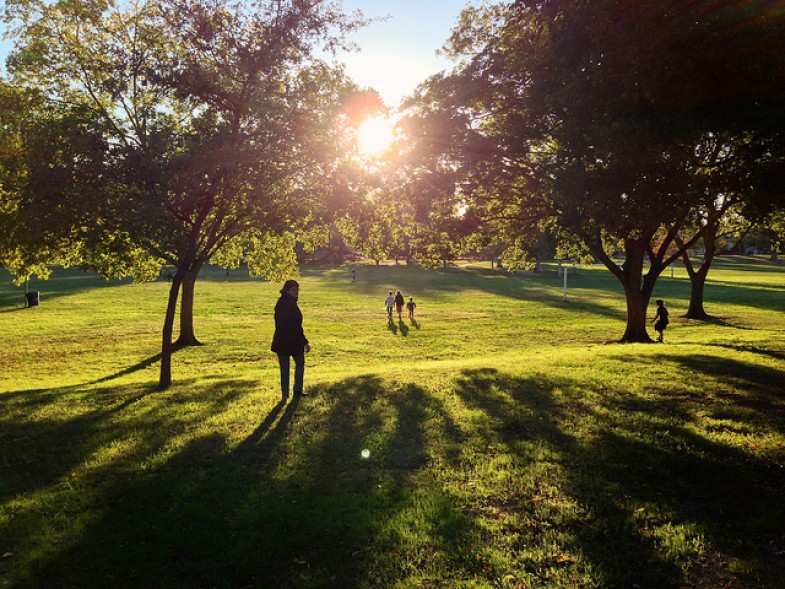The places we all share – the commons – vary in many ways. Some are busy places; some are quiet. Some are designed as pass-through places; others invite us to stay awhile. They all are important to our lives. Now new research shows that green, natural spaces—including playgrounds, learning environments, neighborhoods, even exercise environments— offer particular health and well-being benefits.
•Workplaces
A study published in a recent issue of the Landscape Research journal presented some of the benefits of greenspace in or near working environments. The site of this particular study was a science complex on the edge of a city. Employees had access to a natural area near their workplace and frequently went there during their breaks. When interviewed, these employees described a range of benefits they received from their outdoor breaks and linked these benefits with the naturalness of the environment. They said that nature helped them feel calm and relaxed, that it restored their ability to focus, and that it helped them feel good about themselves. Their comments were consistent with other research studies indicating that nature relieves anxiety and fosters a sense of well-being.
•Schoolgrounds
Nature-based learning is gaining momentum in schools around the country. Many schools are developing gardens and using them to engage students in more meaningful and interesting learning activities. While garden-based activities are often used for science, other areas of learning are addressed as well. Consider the Desert Oasis Teaching garden on the grounds of the Albuquerque Academy, for example. Math teachers use the garden for measuring, estimating, and charting. History teachers link current gardening practices with Native American customs and ancient irrigation practices. Literature teachers take the students to the garden for reading and writing poetry and developing personal essays.
Some schools are also adding more trees, bushes, and grasses as a way to boost grades, even if students aren’t involved in the planting and tending of the grounds. Several studies have shown that just seeing greenery from school buildings can foster academic achievement. Viewing nature, it was shown, helps students deal with attention fatigue and stress. This proved to be true for both high school and elementary-age students
•Playspaces
Another trend generating a lot of interest relates to natural playspaces for children. A natural playspace differs from a typical playground in that natural elements (such as logs, rocks, bushes, and gardens) are more dominant than manufactured equipment (such as swings and slides) in the areas where children play. Kids like these natural playspaces and benefit in numerous ways. Their play is more creative and cooperative, and they have more opportunities for exploration and discovery. Natural playspaces are also better than traditional playgrounds in accommodating different ages, abilities, and interests.
Natural playspaces are being developed in all types of settings across the country – child care centers, schools, city parks, nature centers, zoos, and even backyards. In some places, it’s not a matter of “developing” a natural playspace – as the natural elements are already there. What changes are the rules. Restrictions which kept children from playing with the natural materials were removed. This happened recently at the Indiana Dunes National Lakeshore, where national park rules prohibited visitors from disturbing natural features (plants, rocks, sand, etc.). Prior to the change in rules, children’s activities were generally limited to hiking on the trails, looking at Visitor Center exhibits, having picnics, and walking on the beach. Some nature play enthusiasts, however, made a point of getting these rules changed. The Indiana Dunes National Lakeshore now has a dedicated section -- called The Play Zone -- where children are free to dig in the sand, move stones about, and use drift wood for making forts.
•Exercise environments
You may have heard of “forest bathing” or “Shinrin-yoku” -- a practice originating in Japan in the early 1980s. Headlines in The Washington Post called this practice the “latest fitness trend to hit U.S.” Forest bathing isn’t really about bathing – it’s a kind of soaking, but not in a tub of water. You soak in all the greenery around you. Or maybe it’s more like a shower of greenery that calms and refreshes you. It also lowers stress levels, boosts the immune system, and improves physical fitness.
But you don’t have to go to a forest to get the benefits of green exercise. You just need a more natural environment in built-up areas. One study compared the benefits of walking in a natural area with a non-natural area. Natural-area walking led to more positive emotions, greater mental acuity, and reduced anxiety. Some doctors are now actually prescribing time in nature as a type of preventive medicine. Exercising in green environments, they realize, can help people achieve healthier levels of blood pressure, increased vitality and energy, a sense of well-being, positive emotions, and higher motivation to exercise.
•Neighborhood greenery
Just the presence of nature around the home and in the neighborhood is known to offer special benefits to children. Babies born to mothers with greater exposure to greenery tend to be healthier than babies born to mothers without nearby nature. And children faced with trauma and stress during their early years of life, tend to show more resilience and cope better when they have access to nature around their home. Nature doesn’t remove the stress, but it does serve as a buffer, reducing some of the negative impact on their lives.
There’s plenty of research today attesting to the multiple benefits of nature for humans. People with access to nearby nature tend to be healthier overall than other individuals and are more satisfied with their home, their job, and life in general. The fact that we don’t all have equal access to nearby nature becomes an issue for anyone concerned about a fair and healthy society.
Many see this as an environmental justice issue and are addressing the concern by looking for creative ways to make nearby nature a reality for everyone. Environmental justice efforts have traditionally focused on exposure to environmental risks, such as contaminated soil or chemical toxins in the air and water. Today, there’s a growing understanding that environmental justice also requires equitable distribution of greenspaces. Based on the idea that everyone has the right to a healthy environment, efforts to green the commons warrant both applause and support.







